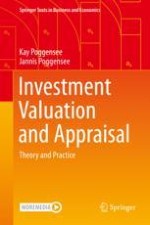2021 | OriginalPaper | Buchkapitel
4. Selection of Alternatives and Investment Programme Planning
verfasst von : Kay Poggensee, Jannis Poggensee
Erschienen in: Investment Valuation and Appraisal
Aktivieren Sie unsere intelligente Suche, um passende Fachinhalte oder Patente zu finden.
Wählen Sie Textabschnitte aus um mit Künstlicher Intelligenz passenden Patente zu finden. powered by
Markieren Sie Textabschnitte, um KI-gestützt weitere passende Inhalte zu finden. powered by
Abstract
-
Have identified the problem of selecting alternatives among several worthwhile investment projects using the techniques of dynamic investment calculation.
-
Know the reasons for the lack of the possibility to select alternatives among several worthwhile investment projects using the techniques of dynamic investment calculation.
-
Know the techniques of removing the reinvestment premise and fictitious investment to select alternatives among several worthwhile investment projects.
-
Are able to use the techniques of removing the reinvestment premise and fictitious investment to select alternatives among several worthwhile investment projects.
-
Know the problem of the ambiguity of the internal rate of return method and you are able to resolve it.
-
Know and you are able to apply the utility value analysis as a technique for considering multidimensional target functions in investment decisions.
-
Know and you are able to apply the technique of account development planning as a technique for taking liquidity into account when making investment decisions.
-
Know the Dean Model and you are able to apply it to problems of operational investment practice.
-
Understand and evaluate differences in account development planning techniques and the Dean Model.
-
Know and you are able to apply linear optimisation as a technique for considering multidimensional objective functions and liquidity in investment decisions.
-
Are able to interpret the results of programme planning with linear optimisation.
